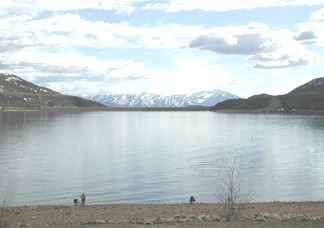2004 Summer Water Supply Outlook
A Warm and Dry March Means More Drought
LeRoy W. Hooton, Jr.
April 12, 2004
|
Utah's unseasonably warm and dry March weather has dashed all hopes of having a normal water year. On April 8, Randy Julander, U.S. Natural Resource Conservation Office snow survey supervisor, told a gathering of the Utah Water Users Association, “We’re worse off this year over last year.” He reported that across the state snowpack has been reduced between 30 and 40 percent with not much of this snowmelt showing up in the streams and reservoirs. For example, the Provo River – Utah Lake – Jordan River Drainage lost 35 percent of its snow with only 3 percent increase in Utah Lake storage. The Bear River, Sevier River and Virgin River basins were identified as the most critical.
The question whether there is still time to turn things around was surmised. “Not likely,” said National Weather Service hydrologist Brian McInerney. “We can’t get back to normal based on the lost snowpack,” he said. A wet spring will help, but the long-range prognostication for Utah does not indicate a wet cycle but rather a 50/50 chance it could be wetter or drier. The odds are better that the weather could be warmer than normal.
What does this mean to Salt Lake City and its water customers? The local canyon snowpack is better than last year. Although McInerney projected only about a 60 percent of normal run-off in the six-canyon streams, Salt Lake City Department of Public Utilities deputy director Jeff Niermeyer believes that there will be more water available for diversion into the city’s water treatment facilities. Little Cottonwood canyon received generous snowfall and the run-off should meet the early summer demand and allow more water to be stored in Deer Creek Reservoir. Furthermore, Little Dell Reservoir is expected to fill. This 20,500 acre-foot reservoir will provide much needed late season water for the city’s municipal water users.
Provo River Water Users Association general manager G. Keith Denos is projecting only a 46 percent water allotment to the Association’s shareholders. The Metropolitan Water District of Salt Lake & Sandy (MWDSLS) is entitled to 61.7 percent of this allotment. Althought below normal, this deficit is offset by the City’s customers’ water conservation efforts last year, resulting in nearly 33,000 acre-feet of carry-over water in Deer Creek Reservoir that can be used this year.
Additional water supply will be made available this year. Beginning next fall, the first 4,000 acre-feet of petitioned Central Utah Project water will be delivered to MWDSLS, bolstering its water supply. According to Central Utah Water Conservancy District Operations & Maintenance Manager Rich Tullis, the district has been conveying water into the Wasatch Front from Strawberry Reservoir, and the district will provide all of its contract water to its petitioners. “The Central Utah Project will do what it was designed to do in time of drought,” said Tullis.
The 5-year drought has had an effect on Utah Lake. The level this year is tracking very closely to the level experienced in 1992, when the lake got so low that water no longer could be pumped late in July. This is of great concern again this year. It’s too early to make a call, but water managers are watching the lake and hoping it will recover this year.
Salt Lake City’s customers can expect similar conditions they experienced last year. With the same level of water conservation, there will be an adequate water supply, with enough water left over for next year in the event the drought continues.
